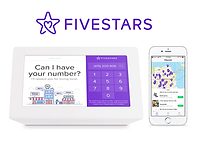Abundant attention focused on touchless door control solutions today

As the future begins to brighten with respect to COVID-19, it is evident that it has reshaped how we live and work. Throughout the pandemic, one subject getting a lot of attention was hygiene and sanitization. Initially it was believed that the coronavirus could be transmitted by touching a surface that an infected person had previously touched, leading people to be wary of everything from payment terminals to doorknobs. The CDC later clarified that while it is possible to be infected by coronavirus through contact with contaminated surfaces, the risk is generally thought to be low. Still, it’s conceivable that the ancient tradition of greeting people with a handshake will become a thing of the past. What’s more, the way we once interacted with surfaces is now becoming hands-off.
As more people head back to work and into public places, the infected-surfaces mindset lingers. After all, there are infectious illnesses other than COVID-19, such as norovirus, that are known to live on surfaces much longer. In addition, the recommendation to reduce touch points in buildings still may be in effect through state or local government directives. Thus, society has been adapting as many functions as possible to touchless mode — tasks such as handling banking and payments, maneuvering through transportation hubs, and controlling elevators and public doors.
Incorporating low-touch and fully touchless door control solutions in your facility may not have been a requirement in the past, but now that the spotlight has shone on the peril of fomites and surface contaminants, it is very likely such solutions will continue to be promoted for use in public places. Incorporating door controls in your building demonstrates your concern for the health and well-being of employees, customers and visitors. Touchless door controls are convenient and provide a pleasant user experience. They also can help your building comply with Americans with Disabilities Act (ADA) guidelines.
When touchless door control solutions are not present, building occupants may be tempted to prop open doors for convenience. This may not only compromise life-safety requirements but security protocols, as well.
The demand for touchless solutions is so great right now that the touchless sensing market across all sectors is expected to grow an average of 17% annually through 2025, according to Orion Market Reports, which states that the main drivers are increasing demand for non-contact detection, sanitation issues, and advantageous programs distributed by governments.
Touchless Door Solutions & How They Work
Touchless solutions may utilize sensors such as facial recognition, voice commands, motion detection or gesture recognition. The latter two are commonly used in door control applications. The purpose of these economical and easy-to-install devices is to help avoid the spread of germs by eliminating the need for people to touch door handles, bars and knobs, thus helping keep your building healthier. They decrease the potential to spread contagious diseases, because hand contact is not required to activate the opening or closing of a door. These solutions are often used with automatic door operators and electronic locks; and they may be integrated with access control systems, life-safety systems, and other solutions.
The nature of your business, how doors are used and by whom, and other factors will dictate which door solutions are best suited for your facility. For example, the strict hygienic requirements of a hospital will demand very different equipment than that needed by a small retail store. There are many choices to help maintain a clean environment around high-use doors, from low-touch to completely touchless, for both interior and exterior doors.
Low-touch mechanical solutions include hardware such as hooks and pulls. In use, a person inserts either their foot into a hook mounted low on the door or tucks their arm underneath a pull mounted at about elbow-height, to pull open the door without touching it with their hand. These solutions are commonly installed on restroom doors. Another option is push/pull hardware, which controls a door by either pushing the device with a hip or pulling it with an arm. An arm pull can be installed on one side of the door and a hands-free exit device installed on the other side.
Low-touch electromechanical solutions, such as electromechanical door holders, are designed to keep doors open during high-traffic periods. In the right security setting — for example, at a workplace where authorized cardholders have already been granted access and at certain times of day like when a large group of employees is leaving one space such as a factory floor and entering another such as a cafeteria — this solution allows people to move freely though a portal without needing to touch any door hardware.
In a fully automated, touchless scenario, the benefits are cleanliness as well as convenience and security. This type of solution may use electromechanical hardware, a low-energy power operator, and a door actuator that controls movement. Someone wanting to pass through the door needs not touch anything to do so.
There are several options for triggering door operation. A user may have a remote-control fob, which they can carry and simply push a button to actuate the door opening for themselves or others. A good application for this is an office building with a large reception area where access to other areas is controlled by a receptionist who carries the fob. Another option is an RF transmitter that automatically triggers a door to open when it comes within range of the receiver. This is a good solution for people who use wheeled carts, such as in the medical field, or in education for teachers who travel from classroom to classroom with teaching materials.
A common piece of hardware for use in a fully touchless application is a proximity switch. With this device a gesture such as a hand wave, within close range of the device’s faceplate (usually 4 inches, but can be adjusted for longer range), causes an optical infrared sensor to signal a door to unlock and an actuator to open the door. Some switches indicate their status and are illuminated for good visibility in low-light conditions.
A passive-infrared (PIR) motion-sensing device provides immediate hands-free door release by sensing the presence of a person and triggering devices to unlock and open a door. They usually are adjustable for either short-range or long-range operation, and have adjustable PIR beam patterns and adjustable sensitivity controls. In addition, they will provide fail-safe operation in the event of loss of power in accordance with life-safety requirements.
Getting the Most Benefit From Touchless Door Controls
These are the main components of a low-touch or fully touchless door control solution. Other equipment also may be incorporated into the scheme, such as door strikes or motorized/electric latch retraction for remote locking and unlocking of the door.
Public door knobs and door handles are some of the most-touched surfaces anywhere. At high-traffic facilities such as schools and universities, hospitals and clinics, industrial complexes, office buildings, multi-family, senior living and more. There may be vast potential to spread infectious illness by touching those doors, but by decreasing human contact with doors through the use of low-touch and touchless door control solutions, you can reduce that risk and support a healthier environment.
Looking for a reprint of this article?
From high-res PDFs to custom plaques, order your copy today!






